 CMO
CMOthe International Society of the Mars Observers
(ISMO)
12 July 2025
at 02:00 GMT
This Web Site is best viewed with Firefox
the world-wide observations of the planet Mars
in association with the recent issue of the
Communications in Mars Observations
(abbreviated to CMO) published by the
International Society of the Mars Observers
(abbreviated to ISMO)
The ISMO Advisory Board consists of
Donald PARKER † (DPk), Christophe PELLIER (CPl), William SHEEHAN (WSh)
Tadashi ASADA (As), Reiichi KONNAÏ (Kn), and Masatsugu MINAMI † (Mn)
On the other hand, the CMO/ISMO Editorial Board consists of
Tadashi ASADA (As), Masatsugu MINAMI † (Mn),
Masami MURAKAMI (Mk; cmo@mars.dti.ne.jp), Takashi NAKAJIMA † (Nj),
and Akinori NISHITA (Ns)
A. Mars at Opposition in Gemini
Mars reached its current ecliptic opposition in Gemini on January 16th GMT. Its closest approach to Earth was on January 12th, with a maximum apparent diameter of 14.6 arc seconds, making it a small approach.

It will continue to move retrograde from now on, then turn pregrade motion in late February and move away. It will return to Cancer and pass north of the Beehive on May 5th. At that time, its apparent diameter will be as small as 6.4 arc seconds, and this observation season will be coming to an end.
A. Started a Gallery Page
B. Breakout of dust storm
A. Comet ZTF (C/2022 E3) to pass by Mars
B. Mars has moved from Taurus to Gemini
C. This Apparition has Ended
D. Mars was in Conjunction
A. 2022/23 Gallery Open
B. Planets at Dawn
C. Occurrence of Dust Storm Similar Martian Season of 2020
D. Possibility of Martian flares at Edom Promontorium
A. This Apparition of Mars is Closing
B. The ASJ Award for the Outstanding Achievement by Amateur
C. Conjunction 2021
A. Mars is Now in Scorpius
B. Now in a Favorable Mars Observing Period
C. Mars is Getting Closer
D. Detection of the shadow of AMEC
E. A Dust Storm Occurrence at the Southern Early Fall (after λ=300°~Ls )
A. Crucial Loss
B. A Biographical Note on Masatsugu MINAMI by William SHEEHAN
C. Mars is Now in Virgo at Dawn
Aa. It Was Our Pleasure to See the Planet Mars Came Back Now to Shine in the Morning Sky
Ab. The 2018 Apparition of Mars Has just Begun
B. Oxus Dark Segment
Ca. Entrainment of a dust disturbance at λ=185°Ls
Cb. Resonances at the beginning of June and aftermath.
Cc. We here show how the overview of the Martian surface changed within a few days:
Cd. The images here show several work from 9 June 2018 (λ=190°Ls)
D. Notable dust disturbance seen at the following area of Sinus Meridiani down to the northern end of Margaritifer Sinus (including Oxia P).
A. Conjunction of Mars with Neptune on 1 January 2017
B. Dust disturbances at the Eos area around 18 January 2017 (λ=301°Ls)
C. The Dust Disturbances continue
A. Mars is Now Considerably High up in the Eastern Sky at Dawn
B. The Planet Mars now Shines in the Vicinity of Antares ( α Scorpii) at midnight
A. Great Loss
B. The planet Mars Has Moved to the Morning Sky
A. The Planet Mars Shines Now in the Morning Sky
B. Don PARKER Leads the Mars Observation Race this Apparition!
C. Occurrence of an Arctic Polar Cyclonic Cloud
A. Conjunction this Year
B. Mars is Now in the Morning Sky
A. The Planet Mars Will be Closest to the Earth on 5 March 2012
B. Protrusions from the Dawn Terminator
C. End of the 2011/12 Apparition
A. No Martian Opposition This Year
B. Conjunction
C. The Planet Mars Passed the Time of Conjunction with the Sun
D.
The Planet Mars Has Come Back in the Morning Sky
E.
The planet Mars will attain the apparent diameter δ=9.0"
A. The Planet Mars Is Now Approaching
B. Mars Is Going Away
C. Establishment of the International Society of the Mars Observers (ISMO)
D. Reformation of the Staff of the OAA Mars Section
E. Animation of Mars in 2010 by Martin LEWIS
F. Death of Professor Audouin DOLLFUS
A. Mars Is Now to the West Side of the Sun just after Conjunction
B. First Announcement of the IWCMO
C. The Planet Mars Is Now Come Back in the Morning Sky
D. Programme of the IWCMO
E. Final Announcement of the IWCMO
F. The IWCMO Has Been Successfully Held in Paris and Meudon
A. First Announcement in 2008
B. CAPEN Crater on Mars
C. 2007/2008 Mars Apparition Ended
A. Mars is Now Back in the Eastern Sky
B. Welcome to the New 2007/2008 CMO Mars Gallery
C. Noachis dust has been entrained!
D. Origin of the Present Noachis Dust Storm
E. Subsidence of the Noachis Dust Storm
F. Resonant Dust Cores at Nilokeras
G. MIYAMOTO Crater on Mars
H.
Sean WALKER's Animated Globe in 2007
A. SAHEKI Crater on Mars
B. The 20th Anniversary of the CMO, and the 10th Anniversary of the CMO-Web
C. The 2005 Mars Apparition Ended
D. 2006 Mars at Conjunction
D bis. Mars Now
A. The spc is coming, just before the southern vernal equinox
B. Now the season has come when the centre of the spc starts to deviate from the south pole
C. Noachis at λ=250°Ls
D. Solis L area at λ=300°Ls
E. Chicken at Mt Hamilton
F. Yellow Planet again at Opposition
A. 2004 Lowell Conference at Anamidzu
B.
First Conference on Percival Lowell at Anamidzu in 2004
C. Bill SHEEHAN
D.
Mars Conjunction
E.
Our planet has come back in the morning sky
A. First CMO Announcement in 2003
B. The 11th CMO Meeting was successfully held on 3, 4 and 5 May 2003
C. Spectacular Dust Storm was observed here in Japan from 4 July through 8 July 2003
D. Great! but Yellow Planet
E. The biggest Mars on 27 August 2003
F. M Serpentis still darkened and widened
G. December storm
A. Jeff D BEISH, ALPO Mars Section and Computing Section, visited Japan and kindly gave an interesting talk to the CMO Members on 24 March at Yokohama.
B.
The CMO Editors interviewed Sanenobu FUKUI, now 86 of age living in Yokohama, and listened to his talk about his finding of a Sun-glint flare seen near Solis Lacus on 10 November 1958.
C.
D. The 10th CMO Meeting:
1) Bill SHEEHAN communicated a comment to us on the results of the water distribution over the Martian surface revealed by Odyssey's neutron spectrometer:
2) Tom DOBBINS (11 May) suggested us to refer to the S&T Site on Odyssey's result.
The 10th CMO Planetary Observers Meeting was held at Ina City, Nagano Prefecture, from the night of 2 August to the morning of 5 August 2002.
A. Edom Brightening on 7 and 8 June
B. Yellow Dust Cloud
C. The 9th CMO Meeting of the Mars Observers was successfully held at Okinawa on 20, 21 and 22 July.
This Web-Site is
Edited by Masatsugu MINAMI† and
Maintained by Masami MURAKAMI (cmo@mars.dti.ne.jp) , and Akinori NISHITA .

Last updated on 9 July 2018
(The Third Series)


to Japanese webpage



First uploaded on 1 March 2024
What's New!
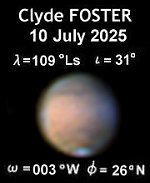
10 July 2025
17:06 GMT
(λ=109°Ls, ω=003°W)
FOSTER, Clyde
Khomas, NAMIBIA
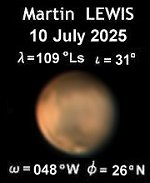
10 July 2025 20:14 GMT
(λ=109°Ls, ω=048°W)
LEWIS, Martin R
St. Albans, the UK
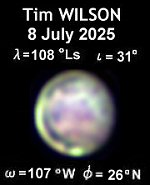
8 July 2025 at 22:27, 23:43 GMT
(λ=106°Ls, ω=107, 119°W)
WILSON,Tim
Jefferson City, MO, the USA
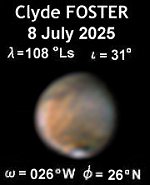
8 July 2025 17:23 GMT
(λ=108°Ls, ω=026°W)
FOSTER, Clyde
Khomas, NAMIBIA
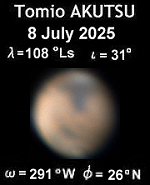
8 July 2025 10:51~11:19 GMT
(λ=108°Ls, ω=291~298°W)
AKUTSU, Tomio
Cebu island, The PHILIPPINES
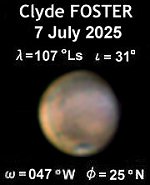
7 July 2025 18:09 GMT
(λ=107°Ls, ω=047°W)
FOSTER, Clyde
Khomas, NAMIBIA
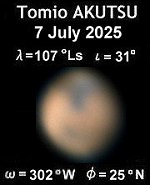
7 July 2025 10:55~11:22 GMT
(λ=107°Ls, ω=302~308°W)
AKUTSU, Tomio
Cebu island, The PHILIPPINES
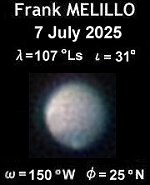
7 July 2025 00:34 GMT
(λ=107°Ls, ω=150°W)
MELILLO, Frank J
Holtsville, NY, the USA


PDF CMO versions from #300 (Dec 2004)

Old CMO Index from CMO #174 (April 1996)
to #289 (April 2004) (in Web versions)
First uploaded on 7 February 2022
Last updated on 6 September 2023
1) Martin R LEWIS
First uploaded on 1 January 2020
Last updated on 19 July 2021
3) Damian A PEACH
2) Martin R LEWIS
1) Teruaki KUMAMORI
First uploaded on 12 October 2017
Last updated on 23 May 2019
Damian PEACH
First uploaded on 23 November 2015
Last updated on 14 May 2017
1) Teruaki KUMAMORI
First uploaded on 1 September 2013
Last updated on 14 April 2015
2) Martin R LEWIS
1) Teruaki KUMAMORI
First uploaded on 1 August 2011
Last updated on 27 October 2012
1) Damian PEACH
2) Martin LEWIS
Closed on 29 August 2010
Revised on 17 September 2010

1) Teruaki KUMAMORI
2) Martin LEWIS
3) Damian PEACH


First uploaded on 9 April 2007
Closed on 6 August 2008
Revised on 7 October 2008


First uploaded on 1 January 2005
Last updated
on 26 November 2006
at 09:00 GMT


1 ) Bill DICKINSON
2 ) Christophe PELLIER
(projection map, see LtE)
3 ) Christophe PELLIER
(polar regions, see LtE)
4 ) Jan ADELAAR
5 ) Damian PEACH

Last updated on 15 October 2005
This Site of CMO Lowell Page was first uploaded on
15 September 2002

Our CMO Web for the 2003 Mars images,
first uploaded on 18 November 2002
Final updating on 15 June 2004 at 08:30 GMT

Also click here for Director's Notices in 2003

2001 Mars Images after the Onset of the Global Dust Storm on 24 June 2001

2001 Mars Images up
until the major dust storm was onset

Here is a history of the CMO Meetings of Planetary Observers
first uploaded on 23 Sept 2002

b) Solar Eclipse on 10 June
a) Our 2001 Leonids

On the Mars Observation Scheme Employed at Fukui in 2007/2008 (PDF 0.6MB)
Masatsugu MINAMI and Takashi NAKAJIMA
Mars Observations in 2005. Part III (PDF 1.3MB)
Masatsugu MINAMI
Mars Observations in 2005. Part II (PDF 0.2MB)
Mars Observations in 2005. Part I (PDF 0.8MB)
Mars Observations in 2003. Part II (PDF 3.5MB)
Mars Observations in 2003. Part I (PDF 0.6MB)
Mars Observations in 2001, Part III (PDF13.5MB)
Mars in 2001, Part II (PDF1.7MB)
Mars in 2001, Part I (PDF 1.5MB)
Mars in 1999 (PDF 1.9MB)
Mars in 1996/97 (PDF 73.1MB)
Mars in 1994/95 (PDF 47.8MB)
Mars in 1992/93 (PDF 44.6MB)
Mars in 1990/91 (Japanese only) (PDF 33.7MB)
All published by
The Fukui City Museum of Natural History

English
Chinese
Japanese


Here you may jump to our favourite sites
(25 August 2010 issue: The furst issue of the third series)
050000 was hit on 21 December 2018 GMT
045678 was hit on 17 June 2018 GMT
044440 was hit on 4 April 2018 GMT
040000 was hit on 10 October 2016 GMT
033333 was hit on 2 January 2016 GMT
Since CMO #207
(25 September 1998 issue)
190000 was hit on 4 April 2021 GMT
171717 was hit on 2 September 2016 GMT
167890 was hit on 19 April 2016 GMT
123456 was hit on 11 January 2010 GMT
and 23456 was hit at the biginning of June 2003.

